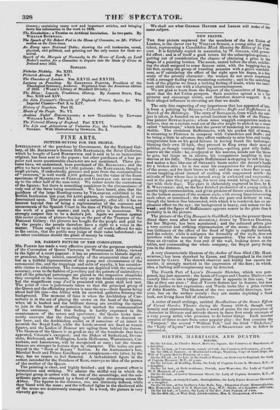MR. PARRIS'S PICTURE OF THE CORONATION.
Ms. PARRIS has made a very effective picture of the gorgeous spectacle of the Coronation of Queen VICTORIA in Westminster Abbey, viewed in the light of a court pageant: it has no pretensions to historic dignity or grandeur, being, indeed, essentially of the ornamental class of art ; but as a faithful representation of the pomp and circumstance of the ceremonial rite, and the trappings and suits of royalty, it has consider- able claims to admiration. The costumes are depicted with the minutest accuracy, even to the fashion ofjewellery and the pattern of embroidery; and all the principal personages are placed in the respective situations
they occupied on the occasion. Not only are the details exactly correct, but the magnificent coup d'ced is presented with great skill and tact. The point of' view is judiciously taken so that the principal group of the Queen and the officiating persons is near the eye—their figures bow, about half life size—the Abbey with its crowded galleries forming the background. The moment of time is when the Archbishop of Can- terbury is in the act of placing the crown on the head of the Queen, when all is hushed and the brilliant throng are awaiting the signal to join in the burst of acclamation that marked the consummation of the ceremony. But this feeling is hardly expressed in the countenances of the actors and spectators : the Queen looks inno- cently unaware that the dazzling symbol is about to descend on her brow, and the Archbishop smiles as if conscious of an intent to astonish the Royal Lady, while the Lords around are fixed as waxen figures, and the Ladies of Honour are ogling from behind the throne. The likeness of the Queen is as good as any of the hundreds that have appeared, CHALON'S excepted ; and the Dukes of Sutherland, Devon- shire, Richmond, and Wellington, Lords Melbourne, Westminster, Cot- tenham, and Lansdowne, will be recognized at once ; but the resem- blances are stronger in feature than in character. The ladies are por- trayed in the "Book of Beauty" fashion. In the Ambassador's box, Marshal Soult and Prince Esterhazy are conspicuous—the latter, by the way, has no reason to feel flattered. A lackadaisical figure in the corner, intended for the Dutchess of Kent, conveys no idea of the person of the mother of the Queen.
The painting is clear, and highly finished ; and the general effect is harmonious and striking. We admire the skilful way in which the principal group is united with the rest of the assemblage, and the sub- ordinate parts are obscured by a flood of sunlight streaming across the Abbey. The figures in the distance, too, are distinctly defined, while they blend with the mass ; and the reflected lights in the shadowed side of the scene are dexterously managed. In a word, the picture is very cleverly got up.
We shall see what GEORGE HATTER and LESLIE Will make of the same subject.






















 Previous page
Previous page